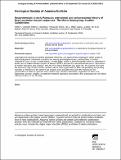Neoproterozoic to early Paleozoic extensional and compressional history of East Laurentian margin sequences : the Moine Supergroup, Scottish Caledonides
Abstract
Neoproterozoic siliciclastic-dominated sequences are widespread along the eastern margin of Laurentia and are related to rifting associated with the breakout of Laurentia from the supercontinent Rodinia. Detrital zircons from the Moine Supergroup, NW Scotland, yield Archean to early Neoproterozoic U-Pb ages, consistent with derivation from the Grenville-Sveconorwegian orogen and environs and accumulation post–1000 Ma. U-Pb zircon ages for felsic and associated mafic intrusions confirm a widespread pulse of extension-related magmatism at around 870 Ma. Pegmatites yielding U-Pb zircon ages between 830 Ma and 745 Ma constrain a series of deformation and metamorphic pulses related to Knoydartian orogenesis of the host Moine rocks. Additional U-Pb zircon and monazite data, and 40Ar/39Ar ages for pegmatites and host gneisses indicate high-grade metamorphic events at ca. 458–446 Ma and ca. 426 Ma during the Caledonian orogenic cycle.The presence of early Neoproterozoic siliciclastic sedimentation and deformation in the Moine and equivalent successions around the North Atlantic and their absence along strike in eastern North America reflect contrasting Laurentian paleogeography during the breakup of Rodinia. The North Atlantic realm occupied an external location on the margin of Laurentia, and this region acted as a locus for accumulation of detritus (Moine Supergroup and equivalents) derived from the Grenville-Sveconorwegian orogenic welt, which developed as a consequence of collisional assembly of Rodinia. Neoproterozoic orogenic activity corresponds with the inferred development of convergent plate-margin activity along the periphery of the supercontinent. In contrast in eastern North America, which lay within the internal parts of Rodinia, sedimentation did not commence until the mid-Neoproterozoic (ca. 760 Ma) during initial stages of supercontinent fragmentation. In the North Atlantic region, this time frame corresponds to a second pulse of extension represented by units such as the Dalradian Supergroup, which unconformably overlies the predeformed Moine succession.
Citation
Cawood , P A , Strachan , R A , Merle , R E , Millar , I L , Loewy , S L , Dalziel , I W D , Kinny , P D , Jourdan , F , Nemchin , A A & Connelly , J N 2015 , ' Neoproterozoic to early Paleozoic extensional and compressional history of East Laurentian margin sequences : the Moine Supergroup, Scottish Caledonides ' , Geological Society of America Bulletin , vol. 127 , no. 3-4 , pp. 349-371 . https://doi.org/10.1130/B31068.1
Publication
Geological Society of America Bulletin
Status
Peer reviewed
ISSN
0016-7606Type
Journal article
Description
This work was in part supported by Natural Environment Research Council grant NE/J021822/1, National Science Foundation grant EAR-0087650, and funds from our respective institutions.Collections
Items in the St Andrews Research Repository are protected by copyright, with all rights reserved, unless otherwise indicated.

